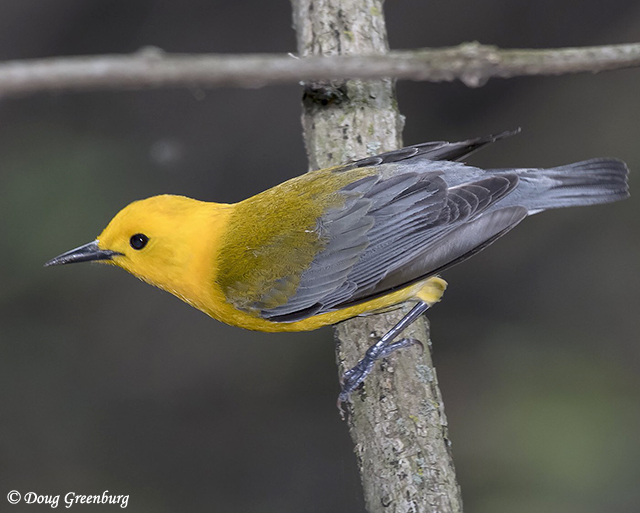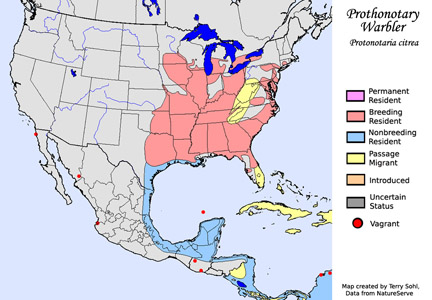| Length: 5.5 inches | Wingspan: 8.75 inches | Seasonality: Migrant |
|
ID Keys: (Male): Golden-yellow head and breast, white undertail coverts,
blue-gray wings.
ID Keys (Female): Females duller but with similar pattern as males. |
||
 The Prothonotary Warbler is
so named because their bright yellow "hoods" are reminiscent of those
of a historical group of official scribes of the Catholic Church. Unlike
nearly every other warbler, they nest in tree holes and sometimes in bird
houses. With the large scale cutting of bottomland hardwoods in the
southeastern United States, numbers of the Prothonotary Warbler fell sharply by
the early 1900s. Numbers are rebounding today, and are helped by
conservationists placing birdhouses in their preferred swampy habitats.
The Prothonotary Warbler is
so named because their bright yellow "hoods" are reminiscent of those
of a historical group of official scribes of the Catholic Church. Unlike
nearly every other warbler, they nest in tree holes and sometimes in bird
houses. With the large scale cutting of bottomland hardwoods in the
southeastern United States, numbers of the Prothonotary Warbler fell sharply by
the early 1900s. Numbers are rebounding today, and are helped by
conservationists placing birdhouses in their preferred swampy habitats.
Habitat: Found in flooded deciduous forests of the eastern U.S. during the summer breeding months, especially around black willow, sweetgum, river birch, ash, and near cypress swamps. They can also be found along forested lakeshores or riparian areas near still or very slowly moving water. They winter in lowland forests and swamps in the tropics.
Diet: Primarily feeds on insects, especially aquatic insects. Will also feed on spiders, seeds, and snails.
Behavior: Usually forages fairly low in vegetation, very often above water. Will also hop along floating vegetation and logs, poking in crevices for food items.
Breeding: Non-breeder in South Dakota.
Song: Clear monotone wheat-wheat-wheat-wheat-wheat. Click here to listen to the Prothonotary Warbler's song.
Migration: Summers throughout much of the eastern half of the United States except for the extreme north. Winters in the tropics.
Interactive eBird Map: Click here to access an interactive eBird map of Prothonotary Warbler sightings
Similar Species: Yellow Warbler, Wilson's Warbler, Hooded Warbler
Conservation Status: Numbers are far less than historical numbers due to massive loss of forested wetland habitat. Numbers in remaining habitat appear to be generally stable, and may actually be increasing in part due to the placement of birdhouses in prime habitat.
Further Information: 1) Patuxent Bird Identification InfoCenter, Prothonotary Warbler
2) WhatBird - Prothonotary Warbler
3) Audubon Guide - Prothonotary Warbler
Photo Information: Photo courtesy of Doug Greenburg.
| Click on the map below for a higher-resolution view |
 |
| South Dakota Status: Rare migrant in the southeastern part of the state. Formerly breeding records existed in the extreme southeast, but the closest contemporary breeding records are in Iowa and Nebraska (SDOU, 2002). |
Additional Prothonotary Warbler Photos (coming soon!)
